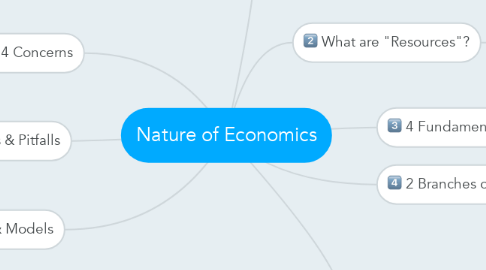
1. Examples of Economic Issues
1.1. Microeconomic
1.1.1. How much steel US company's produce
1.1.2. Price of gas
1.1.3. Unemployment in a particular industry
1.2. Macroeconomic
1.2.1. How much goods & services are produced in the US
1.2.2. US consumer prices
1.2.3. US unemployment
2. Theories & Models
2.1. Ceteris Paribus
2.1.1. Means "everything else equal"
2.1.2. 2 reasons why this assumption is frequently used:
2.1.2.1. Simplify by assuming variables that we are not studying remain unchanged.
2.1.2.2. This allows us to focus on relationships we are interested in.
2.2. Models
2.2.1. Most common are 2 variable graphs
2.2.1.1. like price & quantity on demand & supply graphs
2.2.2. Types of analysis:
2.2.2.1. Normative
2.2.2.1.1. the way it ought to be
2.2.2.2. Positive
2.2.2.2.1. the way it is
2.2.2.2.2. focus of economics
3. Cautions & Pitfalls
3.1. Causation/correlation error
3.1.1. Example:
3.1.1.1. If Event A happens before Event B, it is not necessarily true that A caused B.
3.1.1.2. rooster crows before sun comes up
3.2. Fallacy of Composition
3.2.1. erroneous belief that what is true for a part is necessarily true for the whole.
3.2.2. Example:
3.2.2.1. Real estate market
4. Economic Policy: 4 Concerns
4.1. Efficiency
4.1.1. producing what people want for the least possible cost
4.2. Equity
4.2.1. Fairness
4.3. Growth
4.3.1. As measured by increasing total output (GDP)
4.4. Stability
4.4.1. 3 variables:
4.4.1.1. Steady growth
4.4.1.2. Low inflation
4.4.1.3. Full use of resources
5. What is Economics?
5.1. Definitions
5.1.1. the study of how people, firms and societies choose to allocate scarce resources with alternative uses.
5.1.2. is a social science studying how people make choices.
6. What are "Resources"?
6.1. Natural Resources
6.1.1. Land
6.1.2. Trees
6.2. Human Resources
6.2.1. Labor
6.2.2. Entrepreneurship
6.3. Capital
6.3.1. Machines,tools,buildings used to produce other goods
7. 4 Fundamental Concepts:
7.1. Opportunity Cost
7.1.1. The best alternative that we forgo, or give up, when we make a choice or a decision.
7.2. Scarcity
7.2.1. When human wants are > available resources
7.3. Marginality
7.3.1. Marginal Analysis
7.3.1.1. analyzing the costs or benefits arising from a small change in a choice or decision.
7.3.2. Sunk Cost
7.3.2.1. are costs that cannot be avoided because they have already been incurred
7.3.2.2. spending a lot of money on a software system which becomes obsolete in 1 year due to new innovation
7.4. Rationality
7.4.1. When decisions are made on a cost-benefit analysis
8. 2 Branches of Economics
8.1. Microeconomics
8.1.1. examines the functioning of:
8.1.1.1. Household
8.1.1.2. Firms
8.1.1.3. Industries
8.2. Macroeconomics
8.2.1. examines the whole economy
8.2.1.1. a nation's income
8.2.1.2. a nation's output
8.2.1.3. a nation's employment
